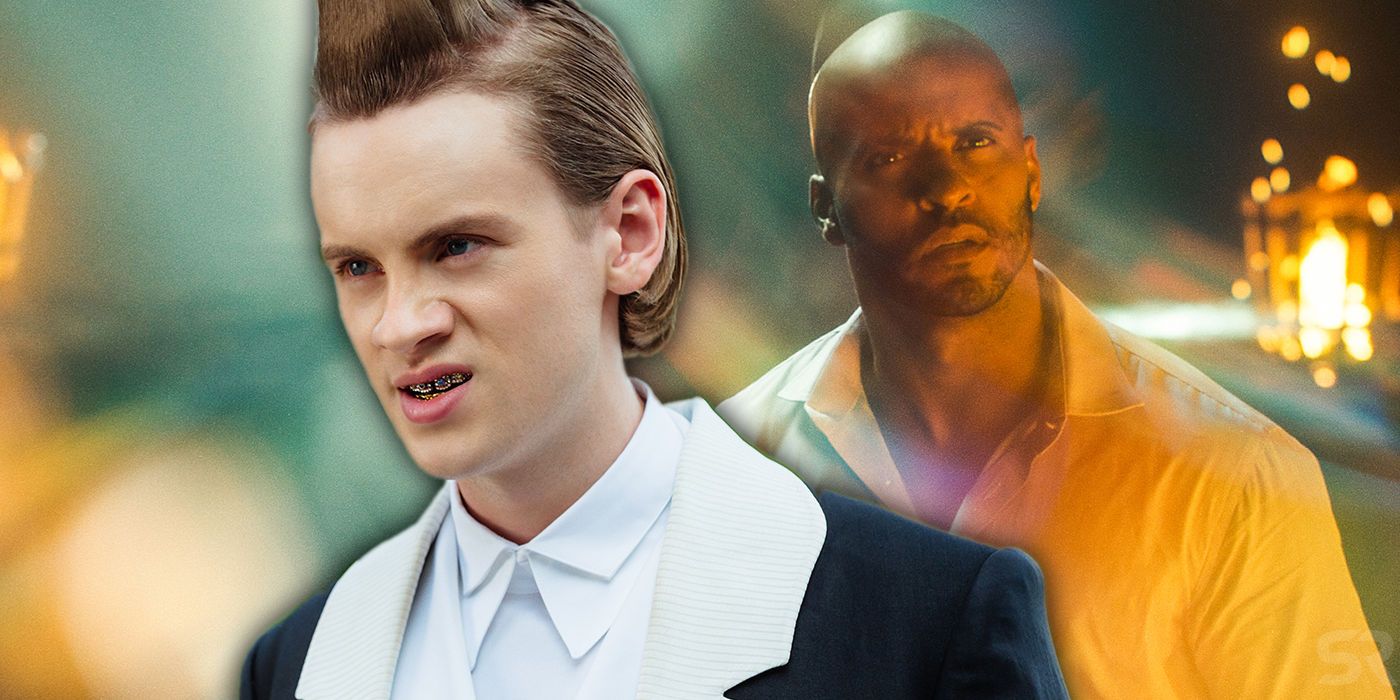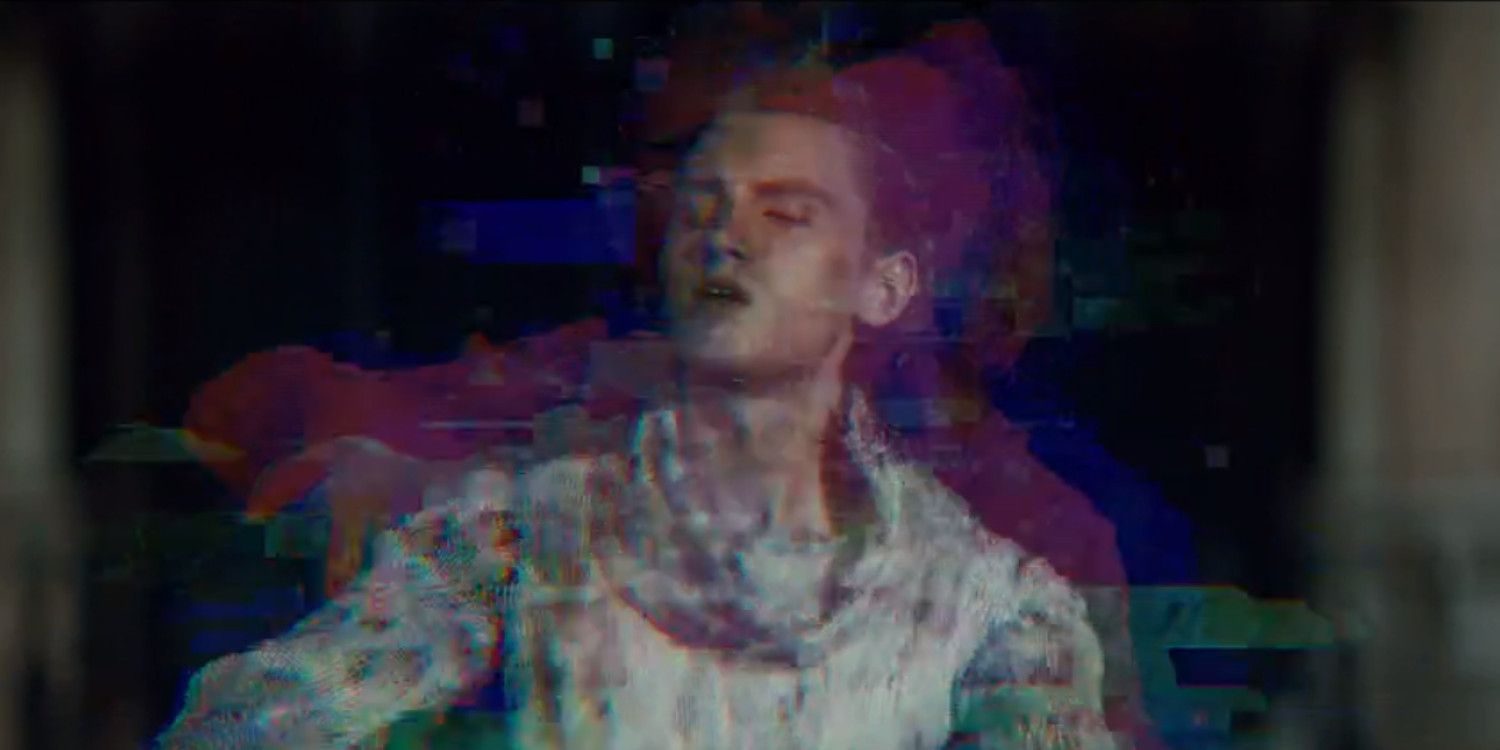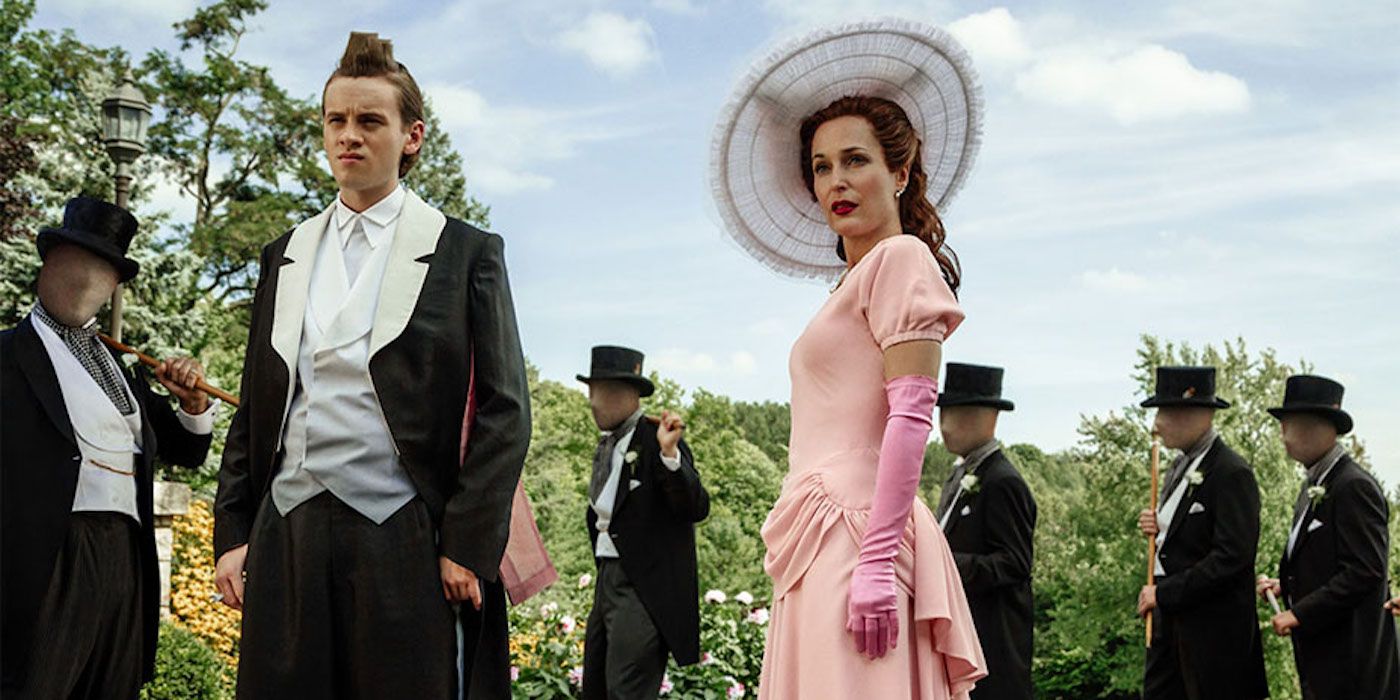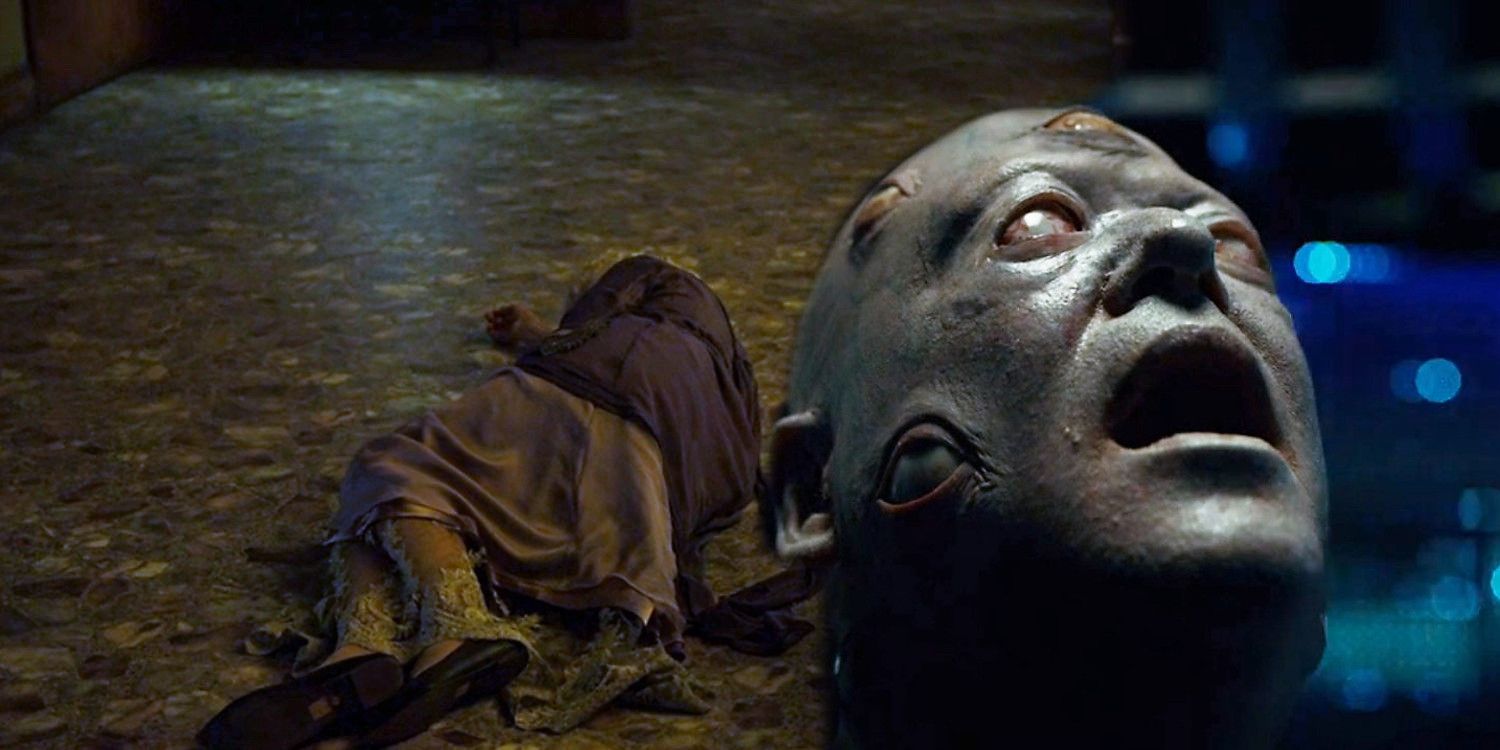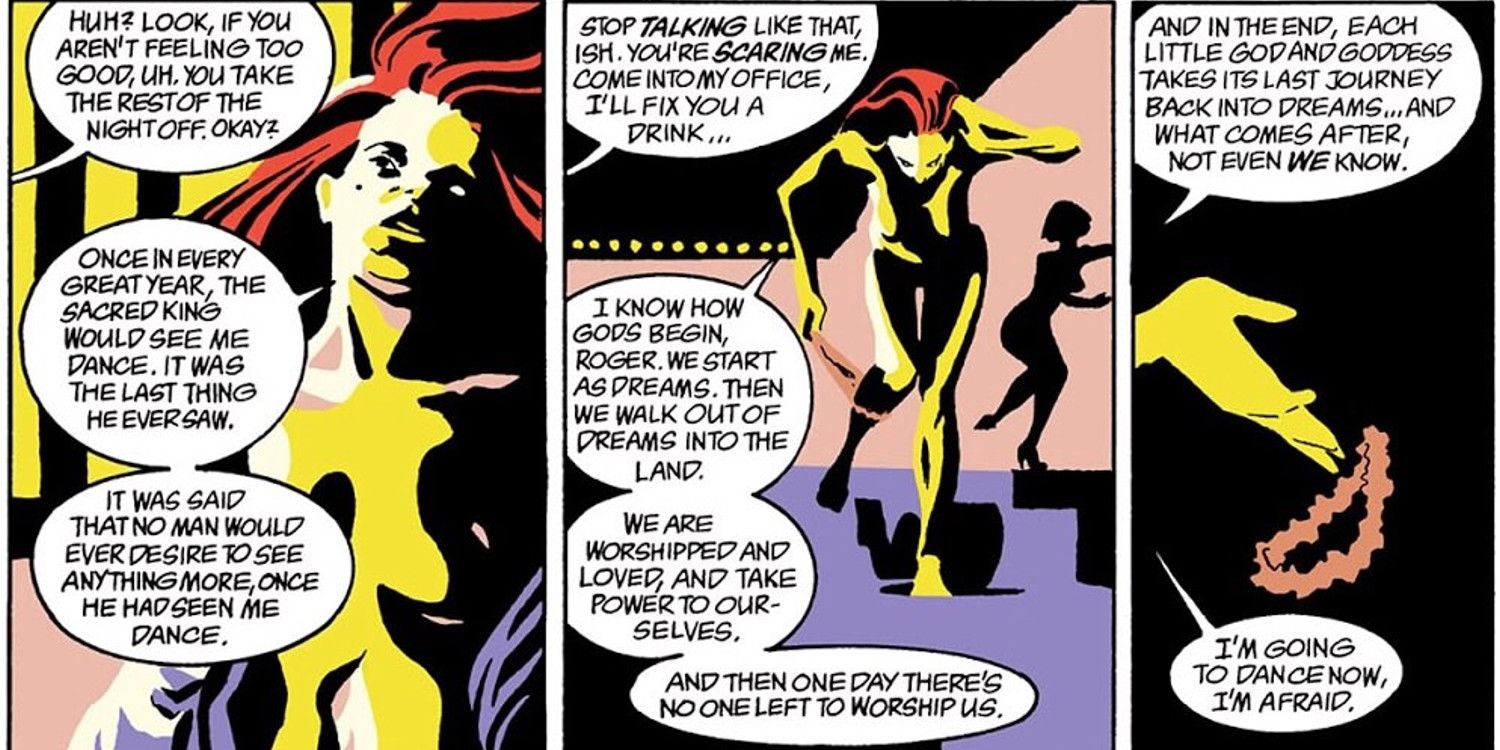American Gods season 2, episode 4, "The Greatest Story Ever Told," does more than any episode of the series to date to explain the rules of how gods are born and how they can be killed. It does this primarily through an opening sequence that reveals the untold origins of the new god Technical Boy and another sequence suggesting his death and possible rebirth.
The plot of American Gods is centered around a growing conflict between the gods of the Old World, who came to the United States with their immigrant followers, and the new gods of the New World, who draw power from the forces Americans believe run the world now, such as Technology, Media, or Money. American Gods season 1 saw Mr. Wednesday (as the Norse God of knowledge, Odin, calls himself now) trying to mobilize the other old gods into an army that will stand against the new gods when war inevitably breaks out. Wednesday also acted to strike down or convert those old gods who had previously joined forces with the new gods, such as Vulcan, the Roman god of fire and blacksmiths.
Related: American Gods Has Made The Story More Interesting Than The Book
While previous episodes have depicted how the various old gods made their way to America with their followers in a number of "Coming To America" sequences taken directly from the novel American Gods, nothing in the book or the show has discussed how the new gods came into being. The series has also been reticent on the subject of just how precisely a god may be killed. "The Greatest Story Ever Told" takes steps to explain both processes in detail and suggests some surprising details about the strength of the new gods relative to their older counterparts.
- This Page: Technical Boy's Birth & Death
- Page 2: Argus & Zorya's Deaths In American Gods & Neil Gaiman's Godhood Rules
The Birth of Technical Boy
The first segment of "The Greatest Story Ever Told" centers upon a young boy and his father somewhere in America. The father is a classical music enthusiast, who forces his son to practice the piano endlessly and lectures him upon how the lives of various composers influenced their music. The son is a technically accomplished musician but he lacks his father's passion. The son's enthusiasm is reserved for computers and video games and he'd much rather play Pong than practice the piano.
The sequence skips forward in time, with the tween son now a college student. Inspired by a sloppy violin player in his dorm and one of his father's lectures on how Bach went on to break his own rules of composition to redefine orchestral music, the son goes on to play an original composition for his father in the same style as Bach's later works. When the astonished father asks his son if he composed this song that so perfectly captured the essence of Bach's oeuvre, the son explains that he wrote an algorithm based on Bach's music with pre-programmed deviations. The end result was a computer program that could create music in the style of an artist so technically perfect that even a trained expert couldn't tell the difference.
Related: American Gods Season 2 Character Guide: Meet The New Gods
Shortly thereafter, the father dies, with the unspoken suggestion that seeing the music that fueled his soul reduced to a series of ones and zeroes by a son who completely missed the point of why he was meant to be studying music robbed him of his will to live. The final scene of the segment shows the son at his father's funeral, apparently listening to the string quartet that is playing as part of the ceremony. Inside his own head, however, the son hears a distorted, electronic beat and from his perspective, at the organ behind his father's casket, we see a pixelated figure slowly shape itself into the familiar form of Technical Boy, tapping at an unseen keyboard as if he were frantically writing code.
The Deaths of Technical Boy and Media
One subtle trait that was shared by both Technical Boy and Media in American Gods season 1 was that they were continually changing their appearances. Nominally this was because their respective areas of influence were built around constant updates, with Technical Boy changing appearance as his toys and apps upgraded. By contrast, Media shape-shifted to present her audience with with whatever image might be most appealing in selling her message.
In both cases, the characters were continually changing themselves in an effort to become something better. This is why Media, after the events of Mr. Wednesday's attack in American Gods' season 1 finale, goes into hiding and dies, only to be reborn as the exponentially more powerful New Media. This suggests that, on some basic level, the new gods are weaker individually than the older, more established gods.
Related: American Gods: Media, Technical Boy & Mr. World Explained
One only need look at the basic power structure the new gods operate under to see that this is the case. While the old gods all seem to have fallen on hard times, they still have enough power to operate independently in their respective spheres of influence. The new gods, by contrast, encourage strength in numbers, having formed a new pantheon under Mr. World's aegis. For all the power that Technical Boy and Media seem to possess, they still ultimately answer to Mr. World for any actions that they take.
The failure to produce results over the past few episodes ultimately leads Mr. World to deliver Technical Boy an ultimatum regarding upgrading the systems that allow the new gods to effectively track the old gods' movements. The final straw comes when Technical Boy fails to persuade his first follower (the college student who created him, now a powerful Silicon Valley entrepreneur) to draw upon the power Technical Boy has to track anyone through their cell-phones to create a next-generation tracking protocol. As Mr. World shows up and New Media enraptures the executive with a pretty picture on his smart-screen, Technical Boy runs for his life, only to fall prey to one of the virtual reality helmets he used to kill people in season 1. It remains to be seen if he will return in a new form, but Mr. World later confirms his death, saying "I retired a god today."
Page 2 of 2: Argus & Zorya's Deaths In American Gods & Neil Gaiman's Godhood Rules
The Deaths of Argus and Zorya Vechernyaya
Two of the old gods have died during the course of American Gods season 2 so far. Zorya Vechernyaya, the Slavic spirit of the Evening Star, was brought down by a sniper's bullet during the new god attack on an old gods conclave Mr. Wednesday had organized at a diner in American Gods' season 2 premiere. Two episodes later, in "Munin," Laura Moon brought about the death of Argus, who was once the many-eyed, ever vigilant servant of the Greek goddess Hera but was revamped by Mr. World into the new god of Surveillance, under Technical Boy's control. Laura killed Argus by stabbing him in a tattoo on his neck, which Mr. Wednesday claimed was the source of his power.
It had been shown earlier in "Munin" that Argus had died several times in the past, being reborn into a new form as time went on and his legend changed. This was revealed as Mr. Wednesday and Laura attempted to track Argus through his realm, wandering through the sites of his previous deaths. This suggests that, for the old gods, death is far less permanent a state than it's for the new gods.
Indeed, by considering the circumstances of the deaths we have seen so far, it seems that it's far more difficult to kill an established old god than it's to kill a new one. The deaths of Media and Technical Boy come about through mental trauma and torture. The deaths of Zorya Vechernyaya and Argus, by contrast, are the result of a direct physical attack. While it's entirely possible that all of these characters may be reborn before the end of the series, it's unclear just how much control each god has over this process, with New Media noting that the former Media's voice still lives on inside her head. Mr. Wednesday also spoke of having died once before, sacrificing himself to himself on the World Tree, and the experience only serving to make him stronger.
One possibility to consider is that a god may become stronger by virtue of having a proper name and legends associated with that name. While it seems that gods do require some connection to a force that people believe in, like Argus gaining power as an avatar of the surveillance state, this method of feeding is less effective than direct worship, belief, and knowledge of a god's existence. This may explain why the new gods, who are known only by abstract descriptions of their functions, like Technical Boy, are far weaker in a direct conflict than named gods like Odin or Kali and why the new gods tend to favor sneak attacks and subterfuge over direct confrontations.
Neil Gaiman's Sandman and The Rules Of Godhood
It's worth noting that American Gods isn't Neil Gaiman's first examination of the idea of old gods trying to survive in a modern world. This was also a major theme of Gaiman's first great work, The Sandman - a revolutionary graphic novel series which helped to usher in the modern age of comics and promote the idea of comic books as an art form that could be used to tell complex stories for adults. By looking at Sandman and how it treats its deities, we can glean something of how the rules of godhood work in the similar setting of American Gods.
The plot of Sandman focuses upon Dream - one of seven beings called the Endless, who are personifications of forces like Death and Destiny that sentient beings believe must have an intelligence behind them and, in believing so, create such intelligence. Though god-like in their power and their role in looking after all intelligent life, the Endless differ from regular gods in that they do not require belief to fuel their powers. Ordinary gods in the universe of Sandman have a symbiotic relationship with mortals, providing gifts and protection to their followers in exchange for the regular worship, belief, and/or sacrifices that empower them.
Related: How American Gods Creator Neil Gaiman Would Approach a Sandman TV Show
This concept is spelled out in detail in Brief Lives - the seventh book making up the Sandman. It's here that Dream, who is the personification of imagination and stories, embarks upon a quest to locate his missing brother, Destruction. Dream starts his journey by making contact with Pharamond - a former god of travelers and transportation, who settled into a new life overseeing several multinational shipping concerns and a chain of travel agencies. While not as strong as he once was, Pharamond has survived while the rest of his pantheon died off, subsisting on the power offered by tending to people's need to travel and send things from one place to another.
With Pharamond booking his travel arrangements, Dream seeks out several of Destruction's old friends, including Ishtar, the Babylonian goddess of war and sex. Ishtar has not done as well as Pharamond and has been reduced to dancing in a sleazy gentlemen's club, feeding on the lust of her audiences in order to live. At one point Ishtar spells out the life cycle of all gods, whom she says start out as dreams and ultimately return to the realm of dreams once the last person who truly believes in their power dies.
This seems to be a fair representation for how godhood works in American Gods, with new gods such as Technical Boy starting out as little more than the imaginary friends of lone mortals until they find a source of power to draw upon. Old gods, by contrast, lose power as they lose followers, but are still able to maintain some degree of their former glory by sheer virtue of name recognition or a connection to their area of influence, such as Vulcan drawing power from the guns and bullets manufactured in his name. It'll be interesting to see how this idea develops and which dead gods might be reborn as American Gods season 2 continues.
More: American Gods' Biggest Changes From The Book In Season 2

